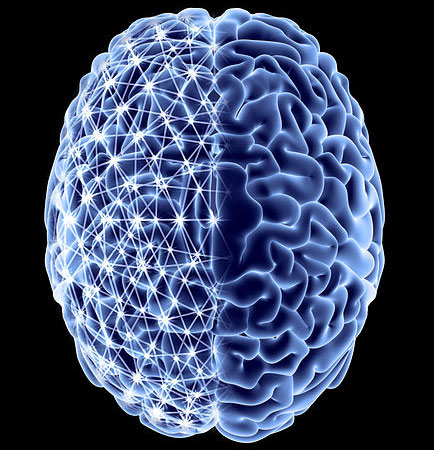Detects two hemispheres that work independently
According to the results of the new study, the mechanism for storing temporary brain information of the brain is similar to the RAM (Random access memory). The computer, the left hemisphere and the right hemisphere of the brain store information separately. together. This result explains why: Why people can only remember a small number of objects at a time, and suggest that people can maximize their memory by providing information. Equal doses for both sides of the brain hemisphere. The results of the study are published online in the Proceedings of the National Academy of Sciences, issued June 20, 2011.
Normally, each person can handle 4 different jobs at once in their memory, such as the position of 4 cards in the centralized game. Although many studies have linked memory to intelligence, scientists still cannot fully understand how the brain reaches this limit.

Two brain hemispheres operate independently
" Why can't you think of 100 things at once, or 50 at the same time? Why is it only 4? " According to Earl Miller, co-author, researcher, working at Massachusetts Institute of Technology, United States. States " If we understand this, we will understand very deeply about how the brain processes and expresses information and mechanisms of conscious thought formation ."
Miller and colleagues conducted experiments on two experimental monkeys (monkeys can also memorize & handle 4 different tasks at once) in a simple task. First, the researchers showed monkeys 2 to 5 squares of different colors, flashing on a computer screen, for less than a second. The second step, the screen will be blank, no color for the same time, and then the squares appear again, but there is a square of colors different from the original color. Monkeys are rewarded for finding this color change.
As the number of squares increases, monkeys have more difficulty recognizing color changes. But Miller and colleagues found that when experimental monkeys were put under pressure, adding a square to the left part of the computer screen did not affect the monkey's ability to identify the color of The squares on the right part of the screen, and vice versa. The two hemispheres of the monkey are operating independently.
Each hemisphere will process image information coming from the opposite side . Since the monkeys can track two squares on each side of the screen, this means the magic numbers in the four squares are actually a sum: two squares are tracked by the hemisphere left and two squares are monitored by the right hemisphere.
While the monkeys are on duty, the researchers also track the activity of rat neurons using electrodes. Some of the changes in Monkey's neuron have revealed to the researchers what time and area of the monkey's brain has been overloaded, and it even indicates the specific square is causing trouble.
The electrodes show, the difference in the performance division of the hemispheres. Increasing the number of squares on one side of the screen will make the activity of the nerve cells unbalanced. But when researchers added even more squares, even on both sides of the screen, there were only a few minor differences in the activity of nerve cells.
The discovery of two independently controlled hemispheres can lead to the introduction of new techniques to increase working memory capacity , Miller said. For example, the information panel fitted evenly to the left and right side of the car's windshield may be more efficient than a limited display on one side of the driver's vision. Or, Miller found, security personnel checking bags at airports can work more efficiently if X-ray screens roll vertically instead of horizontally, when objects move sideways. will lead to waste of the ability of the two hemispheres of the brain.
Discovering how the brain processes objects is important because the ability to work memory reflects the cognitive power measured by IQ, SAT scores and the ability to learn a second language, according to the home. neurologist Edward Vogel, working at the University of Oregon, in Eugene, USA. "The more we know about basic capacity limitations, the more we will be able to understand the different cognitive abilities among different individuals when assessing an issue together ."
- People need to use both hemispheres to communicate
- Prehistoric women and men work independently
- The difference between the left and right hemisphere users
- The 'sixth sense' of the brain detects calories
- Detects genes that affect the body's fat distribution
- TrueSmart Smart Clock can operate independently
- Detects a microscopic element after more than a long time of searching.
- Solar storm creates a brilliant aurora for the earth
- Scary secrets of snakes that until now science revealed
- 6 ways of 'brain scams' make people work harder
- Early work is not conducive to health
- Identify deceitful people at work
 Green tea cleans teeth better than mouthwash?
Green tea cleans teeth better than mouthwash? Death kiss: This is why you should not let anyone kiss your baby's lips
Death kiss: This is why you should not let anyone kiss your baby's lips What is salmonellosis?
What is salmonellosis? Caution should be exercised when using aloe vera through eating and drinking
Caution should be exercised when using aloe vera through eating and drinking